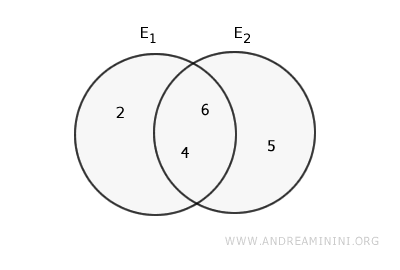Union Event
Given two events \( E_1 \) and \( E_2 \) within the same sample space, the union event, denoted as \( E_1 \cup E_2 \), occurs when at least one of these events takes place.
In other words, the union event (or logical sum) refers to the situation where at least one of two or more events happens. $$ E_1 \cup E_2 $$
This concept is fundamental in probability theory.
You can think of it as the combination of two or more sets of possible outcomes.
A Practical Example
Let's consider rolling a six-sided die.
The sample space contains six possible outcomes, one for each side of the die:
$$ U = \{ 1,2,3,4,5,6 \} $$
Now, let’s examine two distinct events:
- Event E1, "rolling an even number," has the following set of favorable outcomes: $$ F_1 = \{ 2, 4, 6 \} $$
- Event E2, "rolling a number greater than 3," has the following set of favorable outcomes: $$ F_2 = \{4, 5, 6 \} $$
The union of E1 and E2, denoted as \( E_1 \cup E_2 \), occurs when either an even number is rolled or the number is greater than 3.
Therefore, the set of favorable outcomes for the union event is:
$$ E_1 \cup E_2 = \{2, 4, 6\} \cup \{4, 5, 6\} = \{2, 4, 5, 6\} $$
In other words, the union event includes all the outcomes that are favorable to either event.
The probability of the union event is calculated as the ratio of the number of favorable outcomes to the total number of possible outcomes, which means dividing the number of outcomes in the union set by the total outcomes in the sample space.
$$ p(E_1 \cup E_2) = \frac{| \{2, 4, 5, 6\} |}{| \{1, 2, 3, 4, 5, 6\} |} $$
$$ p(E_1 \cup E_2) = \frac{4}{6} = \frac{2}{3} = 0.66 $$
So, the probability of the union event is 0.66, or 66%.
$$ p(E_1 \cup E_2) = 0.66 $$
Visually, if we use a Venn diagram to represent the sets, the union event corresponds to the union of the sets, which includes the area covered by both sets, including their overlap.

In practice, the union event gives a complete view of all possible favorable outcomes from two or more events.
And so on.
